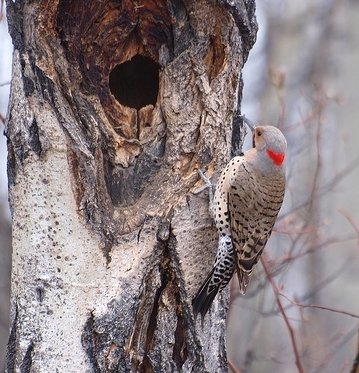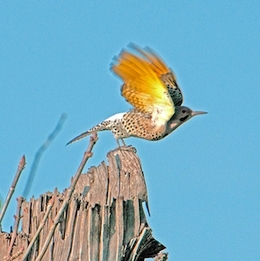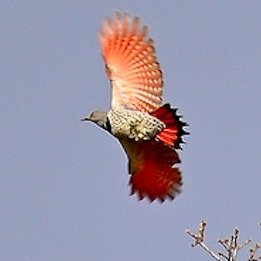





Next to the friendly downy woodpecker, the most common woodpecker visitor in American back yards is the northern flicker. These percussionists of the bird world are best known for their loud drumming.
Subspecies
North America hosts two types of flickers (Colaptes auratus): the yellow-shafted flicker, most common in the east, and the red-shafted flicker, found in western regions. The two interbreed extensively in the Great Plains states, producing birds with hybrid characteristics. Other subspecies include the gilded, Guatemalan and Cuban flicker.
Identification
Although the northern flicker’s plumage is mostly gray and brown, it is anything but plain, exhibiting an interesting patterning of spots and bars. Larger than a robin, it’s also conspicuous because of its size. This bird can reach up to 13 inches long, with a wingspan of 18 to 21 inches.
A distinctive black crescent marks the flicker's chest. In flight, it reveals a white rump, and either bright yellow or bright red shafts on the underside of the wings and tail feathers. The head is slim and round, with a long, sturdy, slightly downcurved bill. The long tail ends in a point. The sexes are similar in appearance except that males have a malar mark or “moustache” while the female has a plain brown face. The malar is red in the red-shafted flickers, black in the yellow-shafted flickers. Range and Habitat
Range and Habitat
Northern flickers are found throughout North America from the Canadian tree line south to Nicaragua. Those in the extreme north migrate farther south during the winter. They prefer open woods and forest edges, parks and back yards.
Diet
Flickers are largely insectivores, eating ants, termites, beetles, crickets, grasshoppers and caterpillars. In the fall and winter, fruits, berries, nuts and seeds become more predominant in their diets.
Habits and Behavior
Because of their fondness for ants and beetles, it’s not uncommon to find this woodpecker foraging on the ground. Like many other woodpeckers, they fly in an undulating up-and-down pattern.
Flickers are renowned for their ability to peck loudly and rapidly on surfaces, a behavior called “drumming”. Not just trees, but roofs, siding, gutters and even metal railings and signs become fair game for drumming as the birds announce their territory and seek to attract a mate. Although some people find the loud pecking annoying, these birds perform a valuable service in helping control insect populations.
Sounds
The northern flicker is a loud bird, both in its drumming and its song. Its call is a rapid, piercing “kekekekekekeke”, that can last as long as 10 seconds. Flickers also make a short, single-note “kyeer” call, and a more quiet, rhythmic and squeaky “flicka flicka flicka”. Listen to the northern flicker at the Cornell Lab of Ornithology website.


Nesting
The northern flicker’s favorite nesting spot is in a cavity of a dead tree. Females lay between six and eight eggs, with both parents taking turns at incubation as well as caring for the chicks. Flickers nesting in northern regions raise only one brood per season, but southern flickers may raise two. Individuals will often return to the same nesting area year after year.
Attracting to Your Property
Although not usually attracted to ordinary bird feeders, northern flickers will readily visit suet feeders. They are also drawn to birdbaths. If you are lucky enough to live on a wooded property, one of the most important things you can do to encourage this handsome bird is to allow trees to retain some dead limbs, as long as they present no danger to humans. Dead or dying limbs or trees attract insects that flickers eat and can also serve as nesting sites. Northern flickers will also sometimes use a nesting box.
Shrubs with berries can provide these birds with food during the winter months. Berries of hackberry, dogwood, Virginia creeper, and blackgum play an important role in their survival during weather too cold for insects.
Photo Credits:
Thumbnail photo by cdbtx
Northern flicker and nesting hole by Bruce McKay
Yellow-shafted flicker by Marshall Segal
Red-shafted flicker by Linda Tanner
Copyright © www.100flowers.win Botanic Garden All Rights Reserved